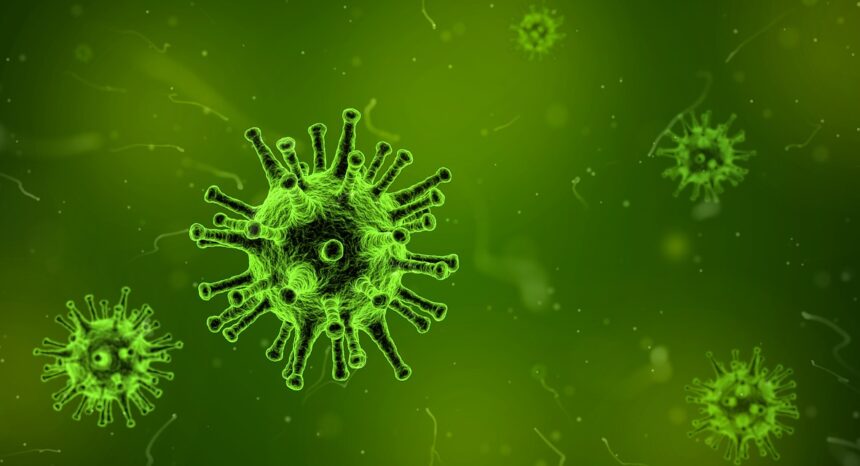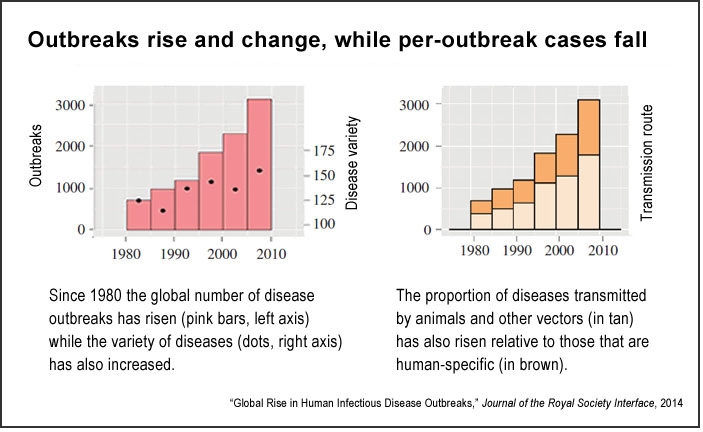The 2014 Ebola outbreak in West Africa dramatically raised awareness of the global burden of infectious disease and raised questions about the preparedness of public health systems. In February 2016, the public scrambled to understand the implications of the Zika virus after the World Health Organization designated it as an international public health emergency because of the suspected relationship between Zika and a rise in cases of a rare congenital condition called microcephaly in Brazil. Although non-communicable diseases are the leading cause of morbidity and mortality in most developed nations, infectious disease remains a major public health concern in the United States and around the world.
Defining and examining the global distribution of infectious disease, in both time and location, is a major research priority. These “spatio-temporal patterns” allow researchers to examine how and why infectious disease does or does not spread. Three terms are used in epidemiology — the study of the spread, causes and consequences of disease — to describe disease distribution:
- Epidemic: A widespread increase in the observed rates of disease in a given population. Diseases such as mumps, measles and cholera can become epidemics, depending on a range of factors.
- Endemic: A consistently heightened rate of disease observed in and associated with a given population over time. For example, malaria is endemic in a number of tropical zones in the world.
- Pandemic: A sudden increase in the observed rates of disease across many populations globally. The most infamous is the 1918-19 flu pandemic, which killed 675,000 people in the United States and millions around the globe.
Note that the term “outbreak” can refer to an epidemic or pandemic. Epidemiologists’ ability to define a disease distribution as epidemic, endemic or pandemic allows health workers, clinicians and policy makers to set local and global priorities for controlling illness and promoting health throughout a population level.
A 2014 study published in the Journal of the Royal Society Interface, “Global Rise in Human Infectious Disease Outbreaks,” examines the global changes in the frequency of outbreaks of infectious disease between 1980 and 2013. In all, the dataset covered 12,102 outbreaks of 215 diseases, with 44 million individual cases in 219 countries around the world. The researchers, based at Brown University, sought to examine the relationship between the location and timing of disease outbreaks and the characteristics of outbreak sites, such as the presence of certain animals that transmit disease to humans.
The study’s findings include:
- The number of outbreaks, and the number of kinds of disease, have both increased significantly since 1980.
- While the number of outbreaks appears to be increasing over time, the data suggest that per-capita outbreak cases are declining: “Despite an increase in overall outbreaks, global improvements in prevention, early detection, control and treatment are becoming more effective at reducing the number of people infected.”
- During the study period, 31% of all human-specific infectious diseases represented 80% of all outbreaks.
- Stomach flu (viral gastroenteritis) caused the greatest number of cases of infectious disease, 15 million, while salmonellosis — an infection typically contracted from consuming food containing salmonella bacteria — was responsible for the greatest number of outbreaks, 855.
- In the data analyzed, 65% of the diseases, making up 56% of all outbreaks, were “zoonoses,” meaning that they were transmissible to humans by animals, insects and other vectors. These include Ebola, HIV, the bubonic plague and Lyme disease.
- Zoonotic diseases have been becoming increasingly diverse over time, but only a small number cause the majority of outbreaks in each decade: “From 1980 to 1990, 80% of all zoonotic disease outbreaks were caused by only 25% of potential zoonoses in the dataset, and only 22% and 21% of zoonoses from 1990 to 2000 and from 2000 to 2010, respectively.” The authors caution that zoonotic disease cases may be undercounted in the nations affected the most because of limited infrastructure and health resources.
- “In contrast to zoonoses … human-specific diseases are declining in diversity and in the impact they have through outbreaks (in terms of per-capita cases).”
The scholars control for the possible confounding role of the Internet, starting in 1990, but note that “it is beyond the scope of this report and our current dataset to determine the role the Internet has played in outbreak detection and reporting.” However, they state that “it is becoming increasingly clear that the Internet can improve disease reporting by supplementing formal surveillance with publicly generated digital disease surveillance.”
Related research: A 2014 report by the U.S. Centers for Disease Control and Prevention found that salmonella was responsible for more cases of illness, hospitalizations and deaths than any other food-borne pathogen. A 2012 study published in Lancet Infectious Diseases reviews non-infectious disease risks from mass-gatherings. A 2011 report by the World Health Organization reviewed the causes of death globally, and identified ways by which to measure progress in infectious disease, among other types and indicators of morbidity and mortality.
Keywords: infectious disease, epidemics, pandemics, outbreaks, communicable disease, disease distribution, global health



Expert Commentary